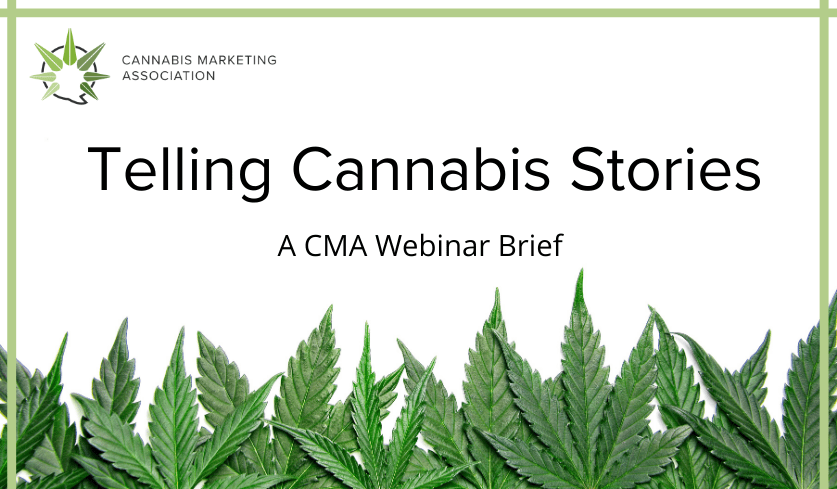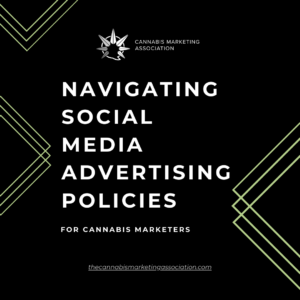Telling Cannabis Stories: A CMA Webinar Brief
(recording embedded)
By Vyla Carter
On October 20, an international crowd met on an online webinar to learn about telling cannabis stories. A panel of four cannabis marketing experts spoke about effective ways to write about cannabis and the main mission when writing these stories.
The panelists included Lisa Buffo, the Founder and CEO of Cannabis Marketing Association; Julia Rubiner of The Herbal Verbalist; Michael Schaeffer Omer-Man, Senior Editor for The Cannigma; and Elana Goldberg, CEO of CannBe.
How Does Telling Stories Help the Industry?
The event kicked-off with the speakers explaining the benefits of telling stories about cannabis.
Telling cannabis stories allows consumers to relate to and feel a connection with the specific person or company that is telling the story, according to Rubiner. It also allows those who want to be educated on cannabis to learn more about the product.
Breaking stigma is also a benefit of telling cannabis stories. Many people have been told their whole lives that cannabis is bad. We need to reach these people and tell them how this plant can help, according to Schaeffer.
These lies have been told to people for years and it is cannabis storytellers’ responsibility to change this stigma.
When we are telling stories, we must keep in mind that the ultimate goal is to create a connection while also recognizing that we are creating a narrative and asking people to challenge their beliefs.
“We are not just telling stories about cannabis, we are literally re-writing the narrative,” Buffo said.
How to Tell Cannabis Stories
When publishing stories about cannabis “you are talking about stories that people have not heard, which is a huge privilege,” Rubiner stated. This industry is new and emerging, so we are not starting from an even ground as if we were marketing a different product.
She went on to say that because we have this privilege, we need to be very careful with our storytelling.
According to Rubiner, we must bend over backward to not make mistakes. The world is looking at us and we want to break the “stupid stoner” stereotype. We are only at the starting point in this industry and must be getting it right, right now.
You can not make health claims as part of your story and have to be careful about who the audience is. In addition, you also must be compliant. There are different regulations in every city and state, so make sure you are following them to the tee.
Goldberg said we need to take the users through stages when telling them stories and to see this process as a layer cake. You need to start by telling them stories that change their beliefs from thinking cannabis is bad. Then you work your way through that process of accepting cannabis consumption at a higher level.
She also said that you should tell your stories in as many mediums as possible. People learn and obtain information differently, so make sure you are catering to everyone. This means giving stories in written form, but also providing visuals, videos, and interactive stories.
Challenges of Telling Cannabis Stories
There are many obstacles and challenges when telling cannabis stories. “As a writer, I view these as problems to be solved with words,” Rubiner said to the webinar attendees.
One of the big challenges that cannabis storytellers face is that you often cannot actually say what you are talking about because of all the regulations, according to Schaeffer.
All reach and campaigns generally have to be organically driven and you must heavily rely on engagement from your target audience. This means that if you do not get someone to click on your picture or headline, you aren’t actually telling the story, Schaeffer said.
“The biggest challenge that we face here is just getting to people,” Schaeffer said.
To make yourself stand out in this space you must first learn what can make you stand apart from your competitors. One of the biggest challenges that comes with this is that everyone is trying to tell the same story, according to Schaeffer. Rubiner said that programmatic advertising can be to your benefit when addressing this issue.
Another obstacle in telling cannabis stories is fear. “We are bumping up against fear, and fear is immediately when people put up their walls and refuse to listen to us anymore,” Buffo said. But, storytelling is a form of validation and can get you in that place of empathy and willingness to share your own stories.
Even with all these challenges in the new industry, there is so much information to share and tell stories about. “I don’t see us running out of topics to cover for at least the next five years,” Goldberg said, which she finds comforting.
Question and Answer Session
The webinar ended with a question and answer session. Viewers in the cannabis industry from around the United States and globe asked an array of questions.
One question posed was “how often do analytics shift how you tell your story?”
Goldberg claimed that analytics do shift how you tell stories, but they are only an indicator. Schaeffer went on to say that everything boils down to two points — analytics tell you where to meet your audience and also tell you what is working and what is not.
One viewer asked if there was any specific wording to avoid when writing cannabis stories.
Buffo answered, saying to read the regulations depending on where you are. “Overdo it when it comes to compliance and claims,” she said. Rubiner followed this up by saying to write for search engine optimization.
Listen to the whole webinar and question and answer session here!
Become a CMA member today to participate in future events like this “Telling Cannabis Stories” webinar and to get access to past webinar recordings and our online Member Portal — full of resources and content for cannabis marketers.



